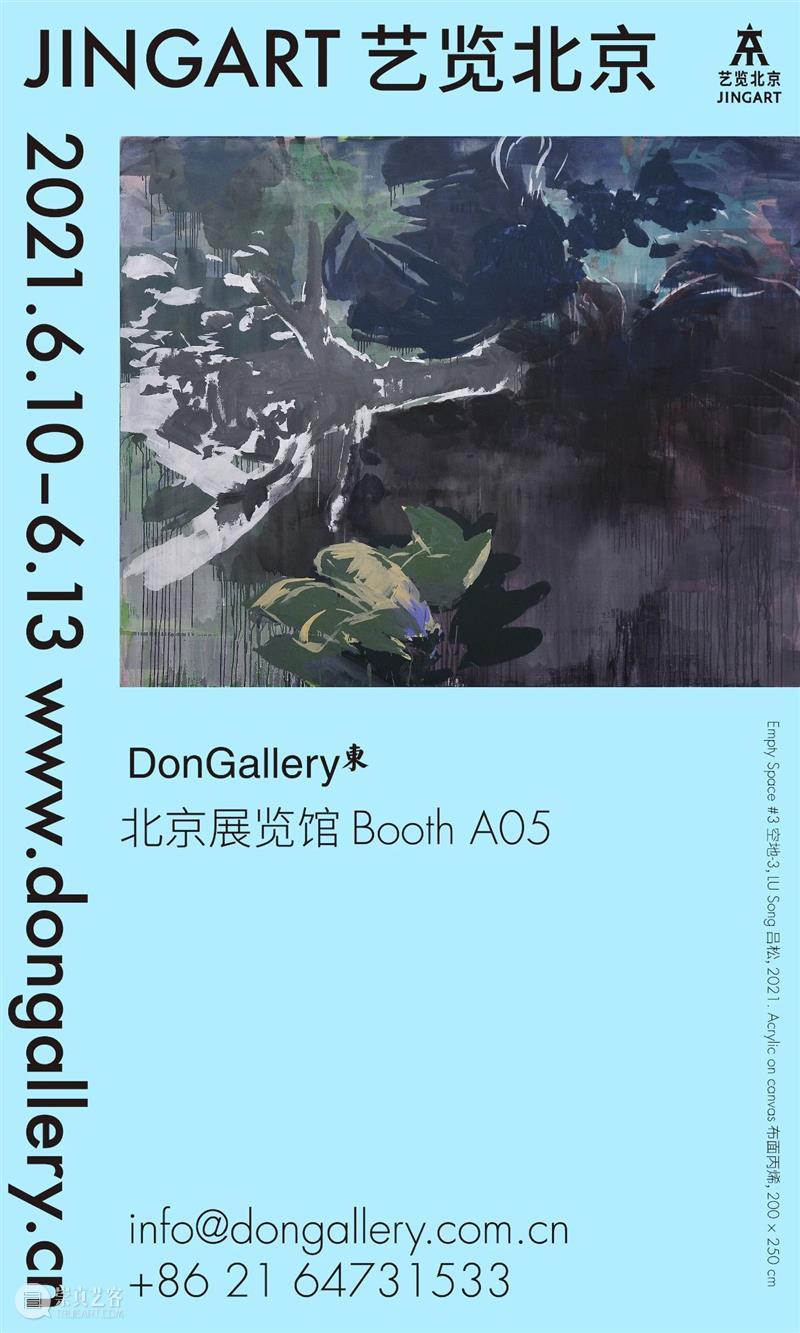
东画廊荣幸宣布将首次在北京参加博览会——第三届JINGART艺览北京博览会,东画廊将携艺术家曹再飞、常陵、郭海强、胡子、九九、李珊、刘任、吕松、曲丰国、张如怡及张云垚作品参展。这些从50年代至80年代出生的艺术家们在作品中对身处的历史背景、社会环境与景作出回应,利用艺术探寻自我表达的语言、赋予画面秩序、思索内心感受、隐喻存在过的痕迹。
Don Gallery is proud to announce that Don Gallery will participate JINGART Art Fair, this is the first time for Don Gallery to participate in an Art Fair in Beijing, to present artworks by CAO Zaifei, CHANG Ling,GUO Haiqiang, HU Zi, Kumi Usui, LI Shan, LIU Ren, LU Song, QU Fengguo, ZHANG Ruyi and ZHANG Yunyao. These artists, born from the 1950s to 1980s, respond to their historical background, social environment and landscape, and using art to explore the language of self-expression, to endow the work with orders, to speculate inner feelings, and to metaphorize the traces of existence.
藏家预览 VIP Opening:
2021/06/10, 14:00 – 20:00
2021/06/11, 13:00 – 20:00
公众开放 Public Days:
2021/06/12-06/13 11:00 – 18:00
地址 Location:
北京展览馆
西直门外大街135号
Beijing Exhibiton Center
No.135 Xizhimen Outer Street
曲丰国 | QU Fengguo
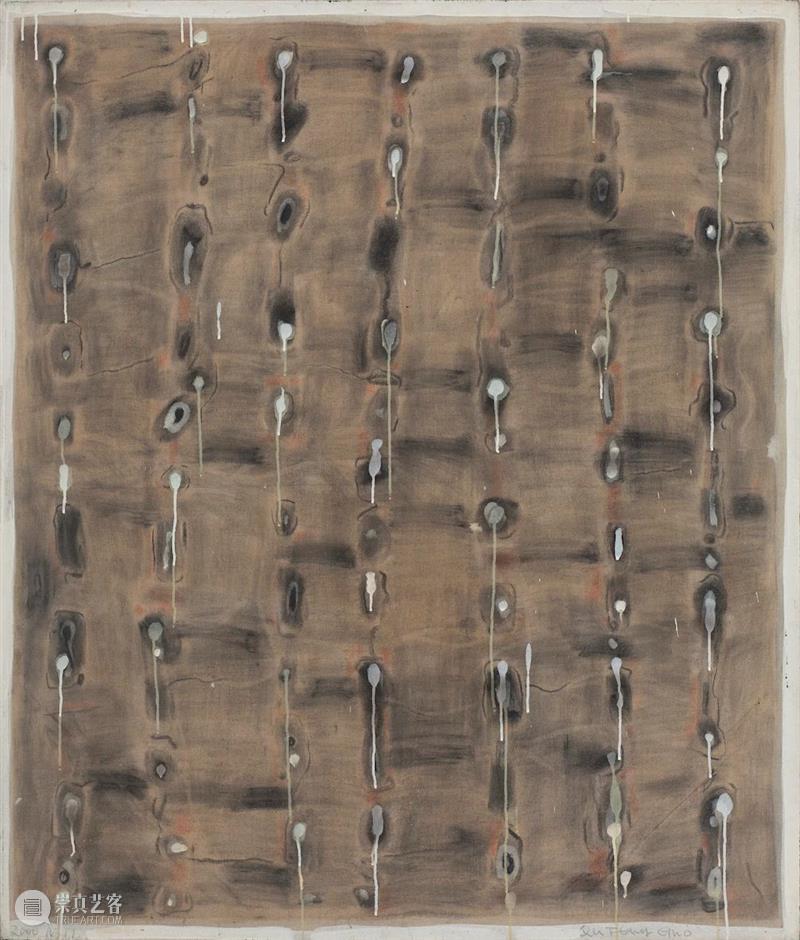
Hand Writing 手迹, QU Fengguo 曲丰国, 2000. Acrylic and charcoal on canvas 布面丙烯和碳粉, 130 x 110 cm曲丰国说:“1990年代中期直到2003年,在手迹系列绘画中我试图放弃传统的绘画工具及材料,直接用手用碳粉在画面上擦拭留下痕迹。一些细小的点或者线不断重复,这批画就命名为手迹。我曾经想过像动物一样,通过触摸留下的痕迹,把自己生的轨迹留下来,让时间在其中展开。从生命的漫长过程里,一般人很难看到结果,那么我就把时间缩短在作品里感受到的生命意义。人无法在混沌状态中持续,情不自禁要为其赋予秩序,无序却又是人存在的证明。我的绘画中总是希冀存在着某个混沌的领域,在此之上赋予秩序。正是拥有自由的精神境界,才能感受到时间的动力,才得以表达出自我的作品。”QU Fengguo said, “From the mid-1990s to 2003, in the Hand Writing series of paintings, I tried to give up the traditional painting tools and materials. I directly wiped the image with carbon powder by hand to leave traces. Tiny dots and lines are repeatedly painted, and these paintings are called Hand Writing. I once thought that, like animals, I could leave the traces of my real life by leaving the traces on canvas and let time unfold itself. From the long process of life, it is difficult for ordinary people to see the results, so I try to shorten the time to feel the meaning of life in the works. Man can't keep on in chaos. He can't help himself give order to it. Meanwhile, the state of disorder is the proof of man's existence. When I am drawing, I always hope that there is a chaotic field where I can give an order. With the spirit of freedom, I can feel the power of Time and express myself in my works.”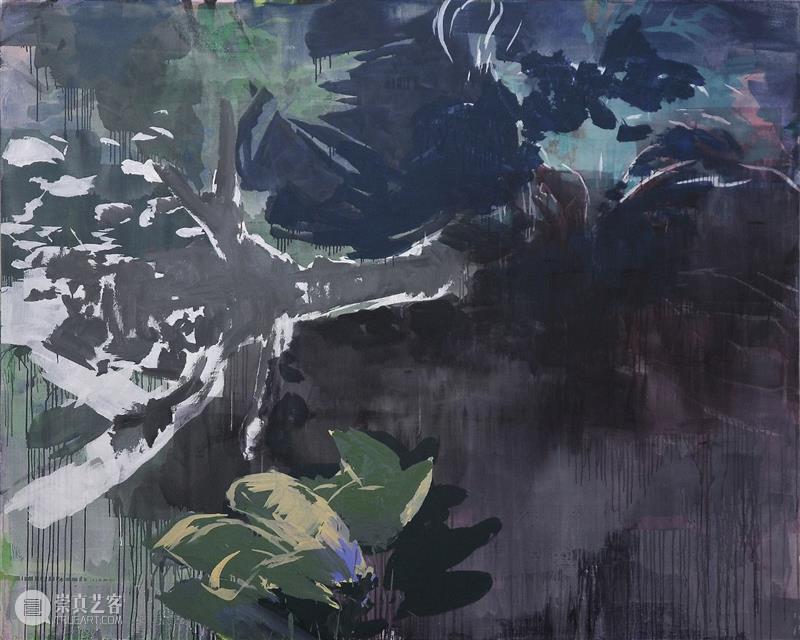
Empty Space #3 空地 #3, LU Song 吕松, 2021. Acrylic on canvas 布面丙烯, 200 × 250 cm吕松如此描述自己的创作:“我的创作过程始于情绪,我从电影文学和个人经历中获取灵感。我的目标就是获得对这些情绪的更深层理解,并丰富自己绘画实践中的感觉。绘画对于我来说就像写作,是一个梳理、归纳和探寻未知的过程。” 吕松此次的绘画,让人一次次凝视同一图景,并获得了不同的心理感受。一直凝视,直至模糊。LU song said, “My creative process begins with emotion. I find inspiration in film, literature, and my personal experiences. My goal is to obtain a deeper understanding of these emotions, and to enrich the feeling within my artistic practice. To me, painting is like writing in that it is a process of sorting, categorizing, and discovering the unknown.” LU presents the same scene over and over again to the viewer, so that they may encounter different states of mind. The same scene, again and again, until it becomes indistinct.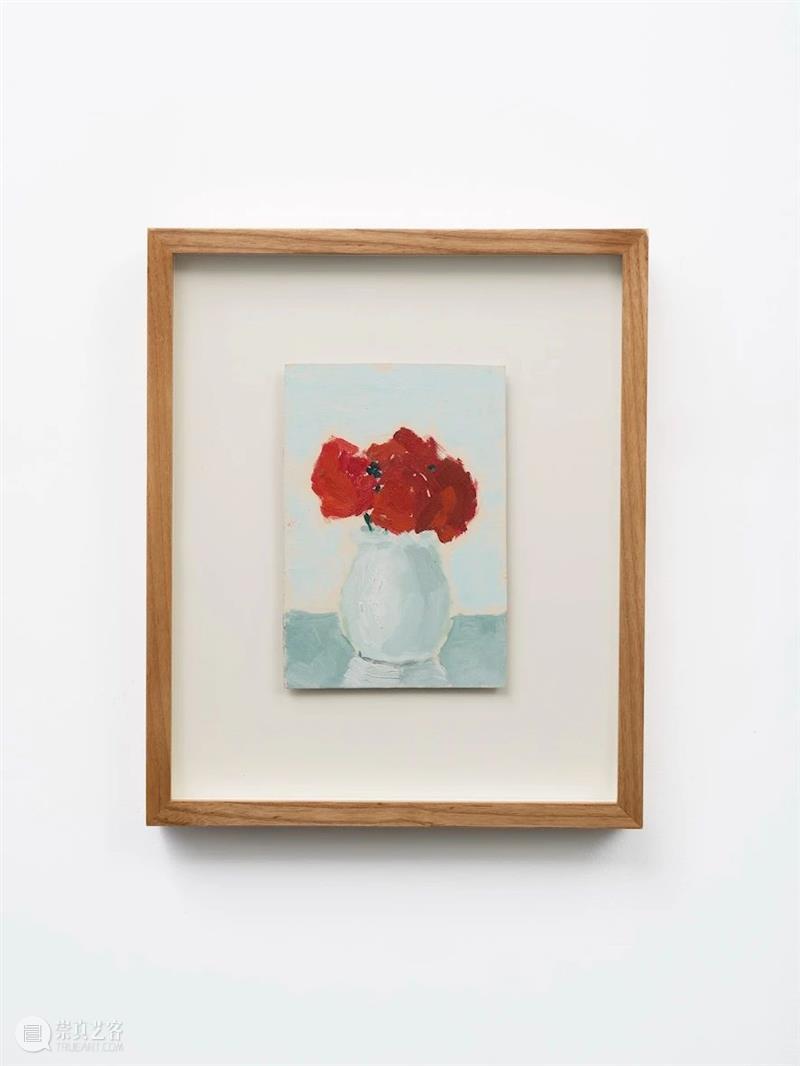
Red Flowers 红花, LI Shan 李珊, 1974. Oil on paper 纸上油画, 19.5 × 13.5 cm
李珊以“非官方”艺术家的身份参加了“无名画会”在1974年的地下展览及1979年相对开放的公共展览,在这一时期创作中,树木、花卉与景观是艺术家始终掌握的母题;高洁的梅花与清雅的菊花都是艺术家的个人肖像,反映着艺术家自己的心理现实。而在最近新作中画面出现的场景多半来自艺术家在世界各地的遨游,而这些新作相较于七十年代的写生在色彩上更加明快鲜亮且都保留着其她娴熟入微的独特笔触。
As an ‘unofficial’ artist, LI Shan joined the underground exhibition of the painting society in 1974 and, later on, in 1979 a less clandestine, more openly public exhibition as a relatively relaxed political atmosphere began to emerge after the Cultural Revolution. Trees, flowering plants, and the landscape are among the motifs which the artist has long embraced; the elegant plum blossom or noble chrysanthemum as personal portraits or reflections on the artist’s own psychological reality. In the recent paintings of LI Shan, many of the compositions and scenes derive from the artist’s extensive travels abroad. Tranquil landscapes contrast the hustle and bustle of city life. Compared to her earlier works from the 1970s, the palette of LI Shan’s new paintings is brighter while retaining the nuanced singularity of her brushwork.
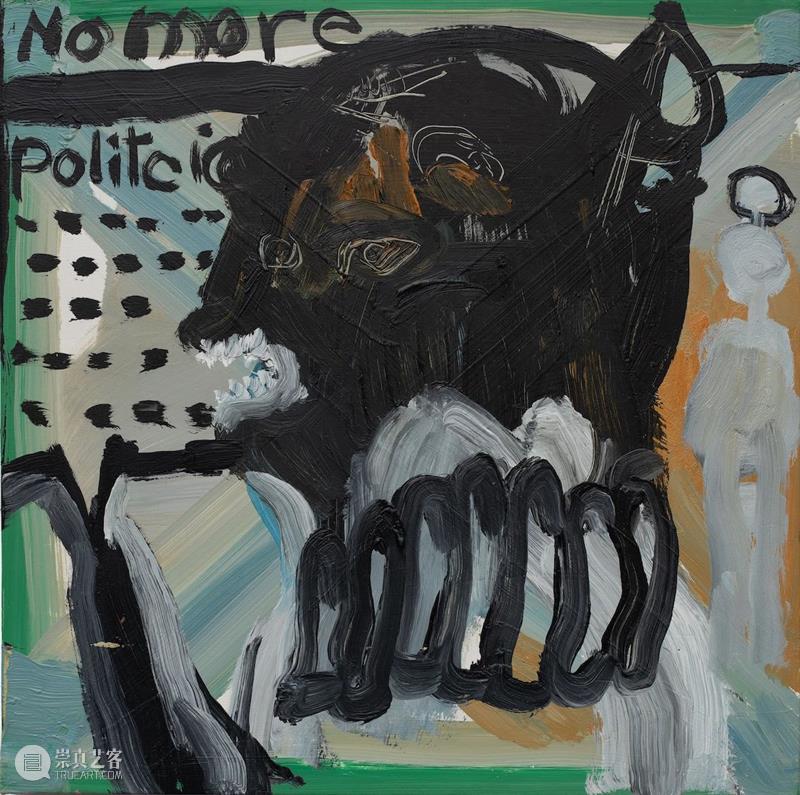
Daily Moods-A little Politician 轻状态—小政治家, CHANG Ling 常陵, 2020. Oil on canvas 布面油画, 49 × 49 cm常陵说:“轻状态的创作是疫情发生后开始的,若说大玄玄社会裡倚着事件感触纪录,那麽轻状态则是在疫情的隙缝裡抛开议题,纯粹以个人意识状态的当下性构成…”CHANG Ling said, "The creation of the Daily Moods series began after the outbreak of the epidemic. If we consider that Illusion Society series relies on the record of events and feelings, then Daily Moods is to put aside the themes in the cracks of the epidemic and consists of the current state of personal consciousness..."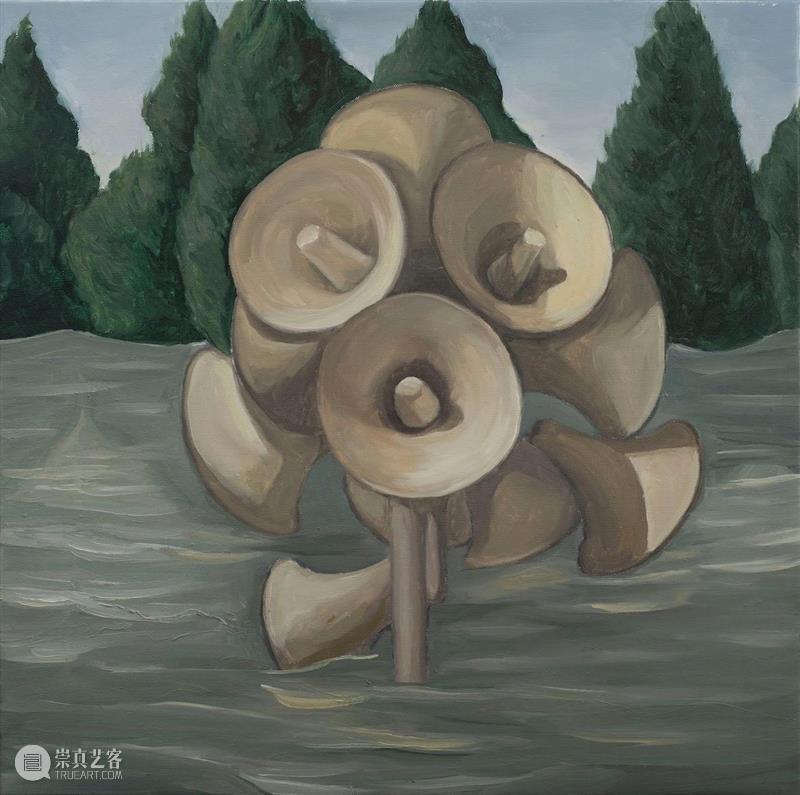
Entrance to A Village 村口, CAO Zaifei 曹再飞, 2020. Oil on canvas 布面油画, 50 × 50 cm曹再飞说:“生活中我是个简单随和的人,常常会迁就、妥协,甚至与世无争,但在艺术上喜欢自我死磕,甚至不在意他人的眼光。长期单兵作战,游离于各个圈层之外,形成了自己独特的视角与思考,既保持理性克制,又喜欢神秘主义,在正经与不正经之间寻找平衡。题材内容都是大家熟知的雕像、名画和日常事物,用一个不经意的动作改变了他们原有的含义,形成了我个人的语法。对我来说绘画语言越简单质朴越好,甚至夹杂着生硬、笨拙,有点范伟式的土味,并自带喜感。”CAO Zaifei said, "In my life, I am a simple and easy-going person, often accommodating, compromising, and even incompetent with the world, but in art, I like to smash myself, and even don't care about the eyes of others. I have been fighting alone for a long time, free from all circles. Formed my own unique perspective and thinking, not only maintaining rational restraint, but also fond of mysticism, looking for a balance between seriousness and irregularity. The subject matter is all well-known statues, famous paintings and everyday things. With a casual movement, they changed their original meaning and formed my personal grammar. For me, the simpler and simpler the painting language is, the better, even mixed with blunt and clumsy, a bit of FanWei’s rustic humor style, and also with a sense of joy.”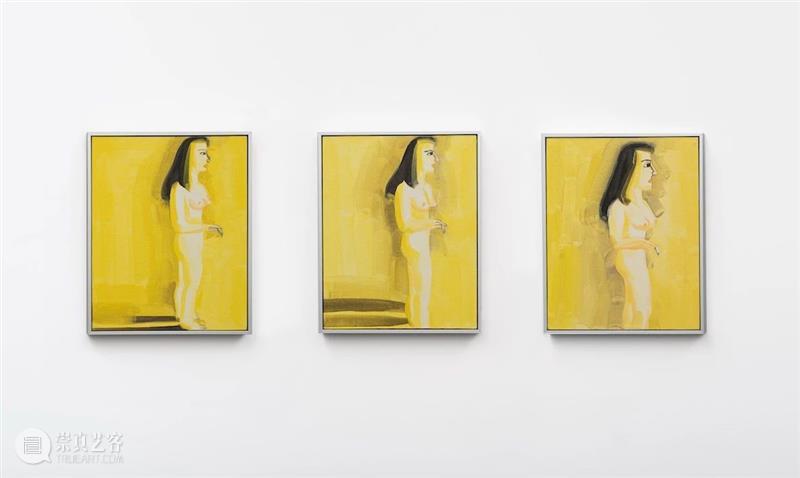
American Loneliness (after Edward Hopper), HU Zi 胡子, 2021. Oil on canvas 布面油画, 30 × 24 cm × 3
American Loneliness (after Edward Hopper) 是艺术家胡子2021年的新作。与之前的肖像作品进行对比,胡子画中的女子侧着身子,阳光从窗外洒进来,照射在女子的身上。女子身后的阴影随着光线的变化,从柔和到强烈。观者透过她的耳朵、鼻子、嘴和手的轮廓,拼出了一幅关于Edward Hopper笔下女子个性的肖像。三幅画分别就像一部电影里的三帧画面,从她右手捏着一根烟的远景镜头递进到了她的半身特写,胡子尝试着把日常微妙、即时的瞬间情绪定格在了空间里。American Loneliness (after Edward Hopper) is HU Zi’s new triptych work. Here, in striking contrast to the depictions of overt facial expressions in all the other portraits of this series. The woman in the triptych stands sideways. The sunlight comes from the window and hits the body of the woman. The light and shadow vary from soft to fierce. The viewer is left to put together the puzzle of a woman’s personality through the minimalistic lines of her profiled ear, nose, mouth and her hand. The works in the triptych are like film frames that zoom out from a close-up to full body shot in which we see her bust. HU tries to freeze the moments which are subtle and instantaneously in her work.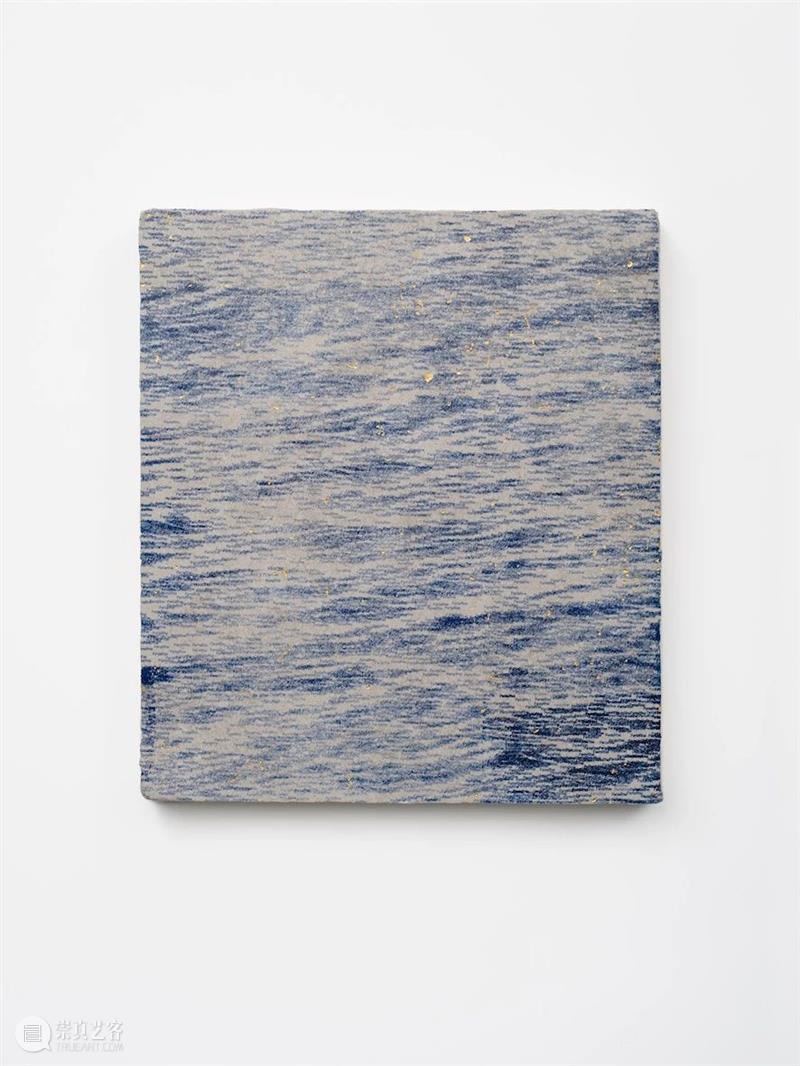
Panta Rhei-202105291533, LIU Ren 刘任, 2021. Silk screening on straw paper, gold foil 丝网草纸 金箔, 62.5 × 54.5 × 6.5 cm在这个系列中,刘任将草纸打成纸浆再重新塑形成厚如砖块的纸砖,当表面被压平与晾干后,再用丝网印刷的方式把颜色深浅不一的“Panta Rhei”字样描摹成海浪起伏的视觉形态,并且最终用金箔嵌入纸砖自然风干过程遗留下的裂隙。刘任动用众多反差性对峙的元素。譬如在直观的视觉感受上,用干枯的草纸去表现潮湿的洋流;在物质形态上,则是作为廉价快消品的草纸被转译为试图指向永恒的艺术品;而在至关重要的主题学范畴内,则是凝固的海与绵延的时间所形成的、互为隐喻的关系。
LIU Ren uses roughly textured straw toilet paper to create a mulch, and then presses the mulch into bricks of paper. After preparing a flat and dry surface on the straw paper bricks, LIU screen prints the words “Panta Rhei” in various shades to evoke the visual form of undulating waves. Lastly, he uses gold leaf to limn the cracks in the paper bricks which are left behind by the air-drying process. In terms of form, this process is like yet unlike painting. In this series, LIU often places elements in direct confrontation with each other. Visually speaking, dry paper is used to evoke the liquid currents of the ocean. While straw toilet paper -- one of the cheapest and most disposable consumer products -- is the chief material used in a work of art which strives at timelessness. In the crucial category of thematics, we find contrast in the mutually metaphorical relationship between the solidified sea and elongated time.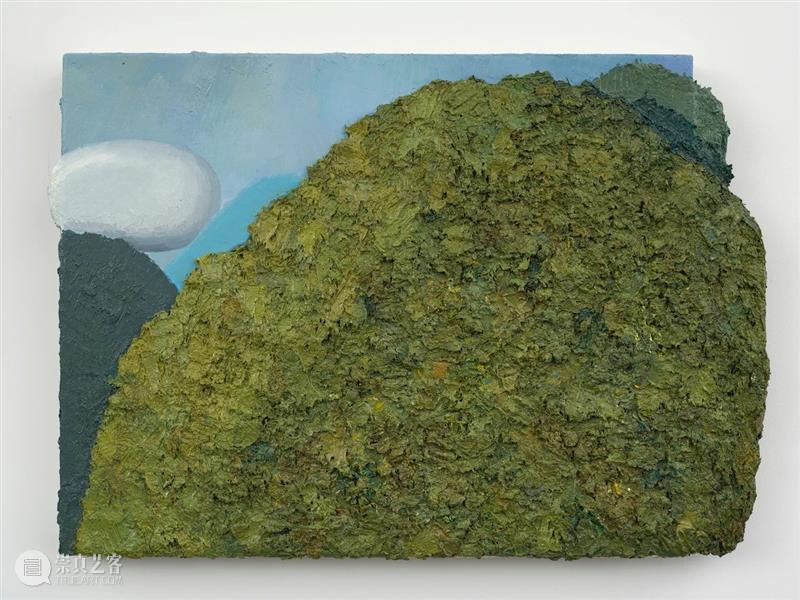
2019.9.13, GUO Haiqiang 郭海强, 2019. Oil on canvas 布面油画, 40 × 57 cm郭海强说:“我喜欢通过写生来锤炼绘画语言,雕塑经验的带入,让画面里散发出充沛的身体感和物质感。用最朴素直接的方式集中色彩和形状的凝聚,把传统手法和当代绘画意识融合。我一年四季在山中穿行,画春暖,画夏阳,画秋爽,画冬藏,日复一日,就像我父母一辈子在地里劳作一样。 ”GUO Haiqiang said, “I like to temper the language of painting through sketching, and then by incorporating my experience with sculpture, the composition exudes a sense of body and material. In bringing together color and shape through this most humble and direct methods, traditional techniques are integrated with a contemporary understanding of painting. I pass through each season of the mountains, painting the warmth of spring, the summer sun, the chill of autumn, and the retiring winter. Day after day, I labor as my mother and father labored all their lives in the earth of those mountains.”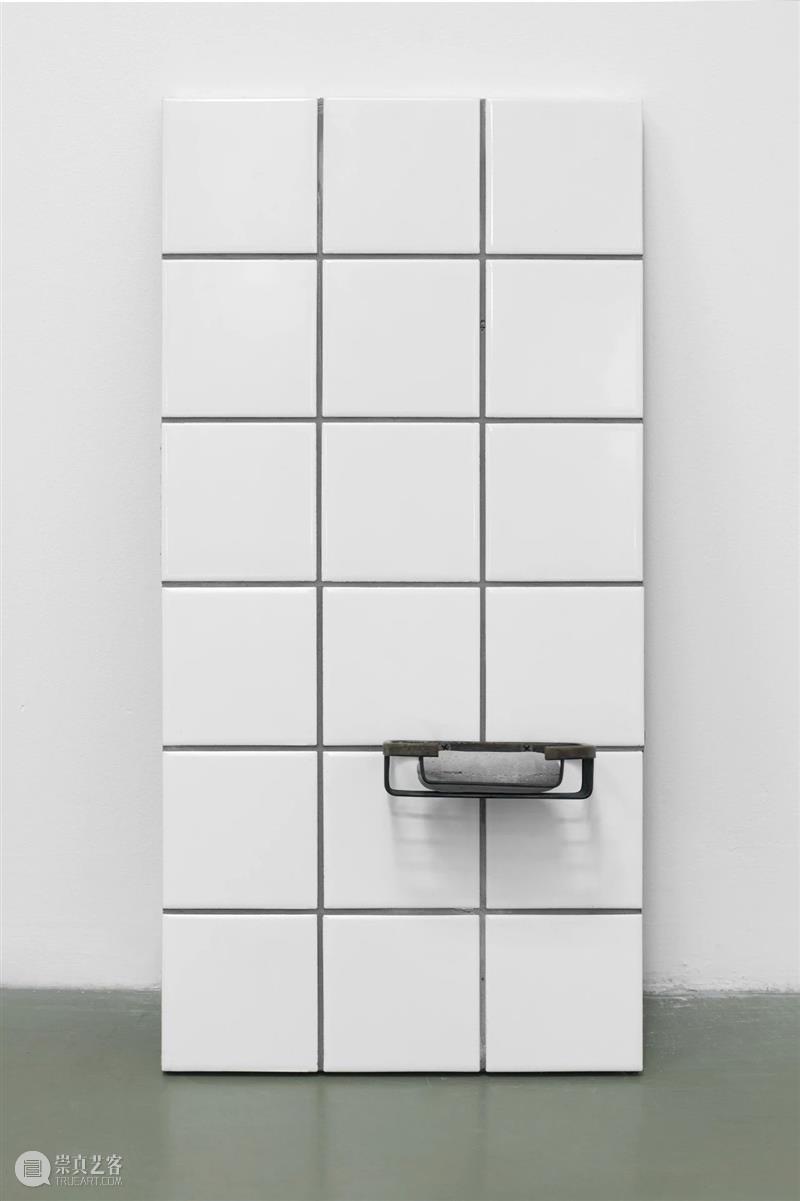
Soap—3香皂—3, ZHANG Ruyi 张如怡, 2017. Concrete, soap holder, tiled board 混凝土, 香皂架, 瓷板, 9 × 5.5 × 2 cm (Soap 香皂), 12.7 × 8.4 × 3.5 cm (Soap holder 香皂架), 60 × 30 × 1 cm (Baseplate 底板)
张如怡在作品中提供了一连串有关跨越与游移的经验以及复杂感受。她针对城市中的建筑、雕塑与场所展开临床分析,通过工业材料进行标本制作,着手公共空间的形态研究。因此,她提取其中的几何结构与节奏表达,同时抓住特定对象的表皮特征,满足装饰的需要。装饰并非独自存在而被强加于其他事物的东西,而是用于自我展现。In her work, ZHANG Ruyi offers a coherent cluster of experiences and mixed feelings about crossing and in-betweeness. She conducts a clinical analysis of architecture, sculpture, and site in the city for the preparation of specimen by industrial materials, commencing on the anatomy of public space. For this reason, she abstracts the geometric construction and rhythmic utterance from within, meanwhile seizing the skin features of specific objects to satisfy the need of ornament. Ornament is not primarily something by itself that is later applied to something else but belongs to self-presentation.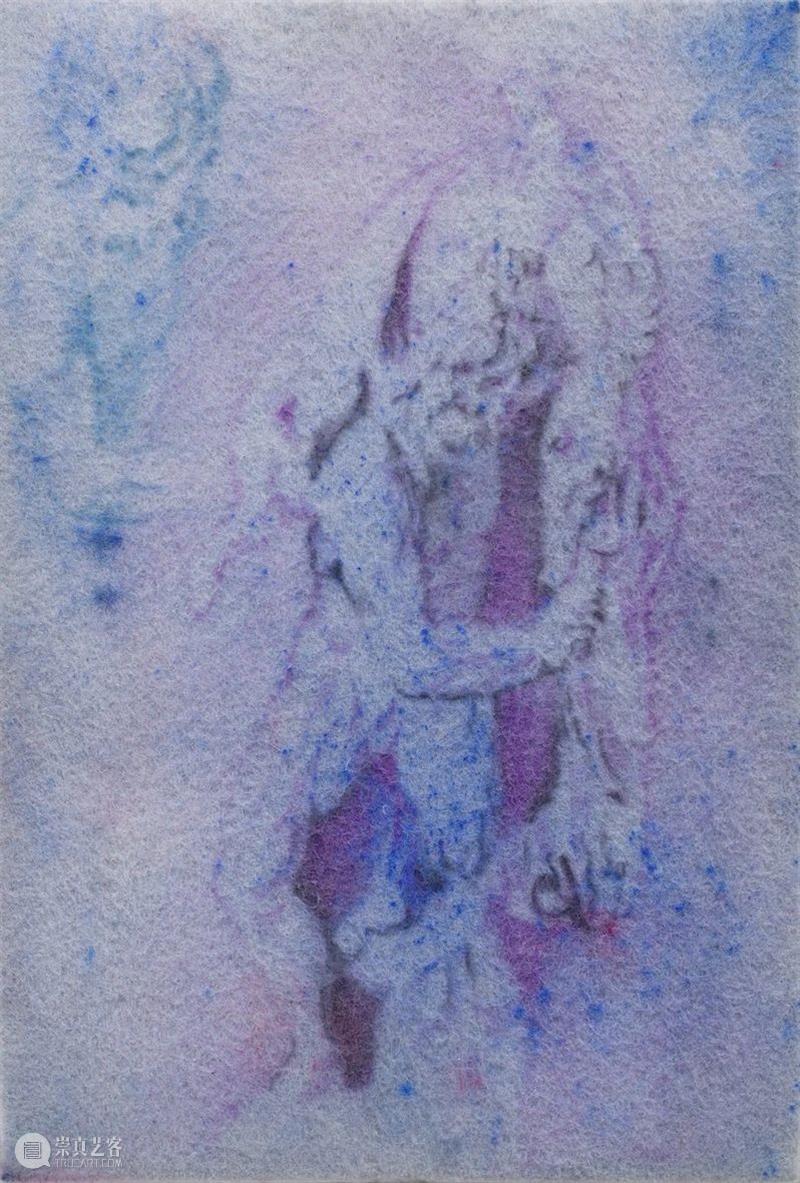
Study in Figures 形体习作, ZHANG Yunyao 张云垚, 2019. Graphite and pastel on felt 石墨色粉毛毡, 22 × 15 cm选择毛毡作为画布,从起点处就决定了张云垚所必须“履行”的一种不可逆的绘画方式,以及对每一处细节的严格执行和强力控制。在其作品中身体在物理空间上是个人所占据的位置,在隐喻空间上又为自我认同与社会关系的互涉提供地方;更关键的是,身体是建构情感本体的场所。艺术家捏造各种虚假的姿态,以此显示对其解剖构造的深入见地,身体在快感的规训下具有了政治性。毛毡的雕塑质感通过对肉身、躯干和肢体的召唤得以实现,终结了强加于身体的压制与漠视。
Working with felt as a canvas, ZHANG Yunyao is “voluntarily forced” into an irreversible method of painting, which demands rigorous execution and an ironfisted grasp of every detail. Whereas body is the location occupied by an individual in physical space, it provides a place for the interplay between self-identifications and social relationships; more importantly, body situates itself as a site for the construction of sentimental noumenon. By fabricating highly stylized poses, the artist is showing an advanced understanding of anatomy, among which the body is disciplined by pleasure and thus becomes politicized. The sculptural appearance of felt is concreted by the powerful evocation of the mortal flesh, which ends the ignorance and suppression on body.
九九 | Kumi Usui
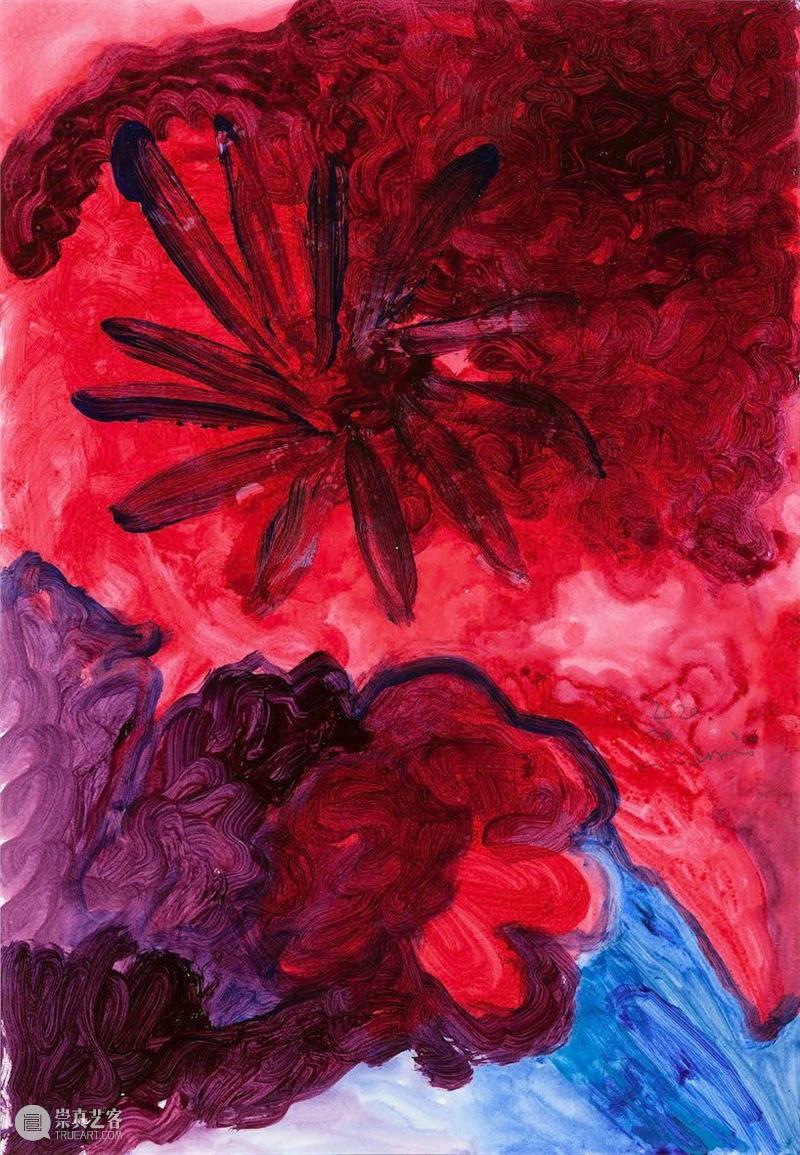
I’m Drawing & Drawing 2020 #34 埋头画画 2020 #34, Kumi Usui 九九, 2020. Acrylic on paper 纸本丙烯, 39 × 27 cm
九九的创作主要涉及纸本丙烯、综合材料绘画及装置。其创作观念及创作实践围绕日常生活与情感展开,并在《埋头画画》系列作品中尝试模糊生命与绘画的边界,试图回到绘画的本质状态进行无目的性的绘画,审问绘画本身的意义、生活的意义与自我的意义。
Kumi Usui’s work involves acrylic on paper, painting with mixed media, and installation. Her conceptual practice centres on everyday life and emotions. In the series of I’m Drawing & Drawing, she tries to return to the pure state by blurring the boundary between art and life when creating aimless paintings, questioning the meaning of drawing, the truth of life, and the connotation of self.
当前展览
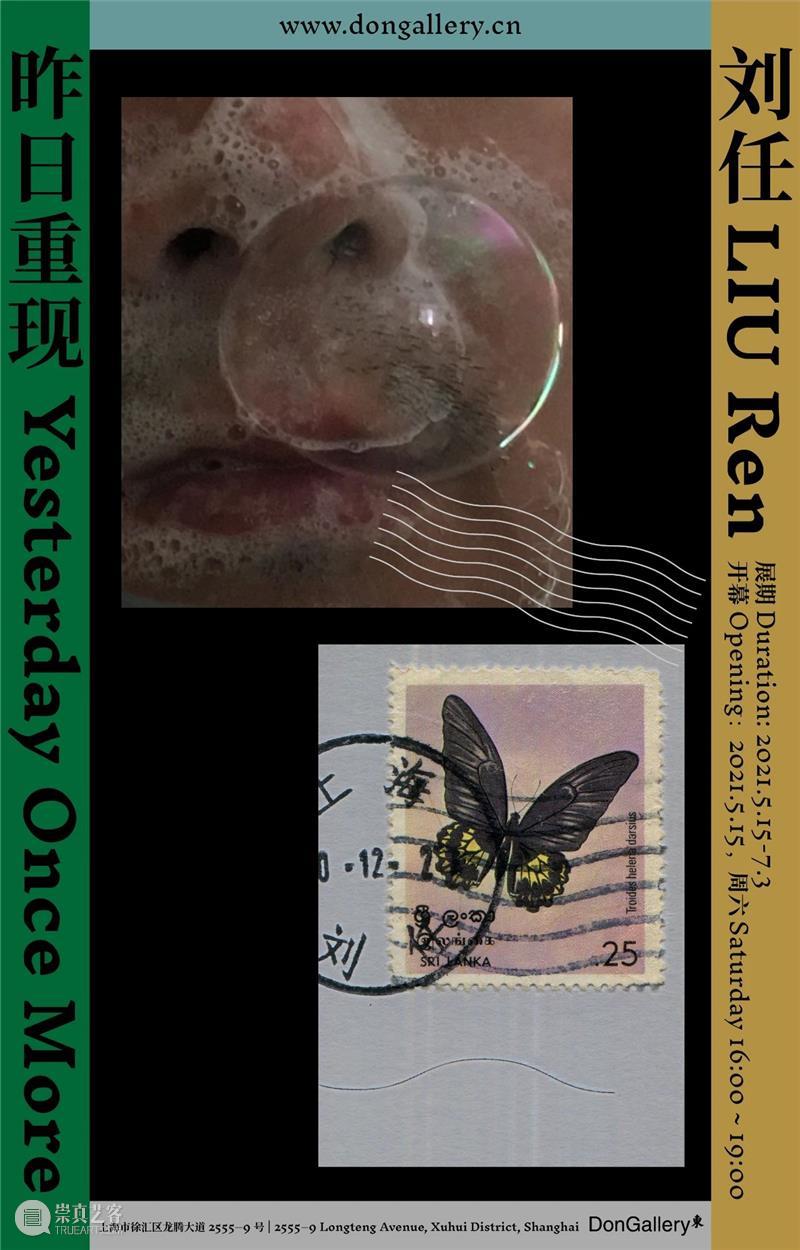
刘任个展《昨日重现》
相关链接:东画廊 | 刘任个展“昨日重现”将于5月15日开幕
東画廊 Don Gallery
上海市徐汇滨江龙腾大道2555-9号
2555-9 Longteng Avenue, West Bund, Shanghai
+86 21 6473 1533
www.dongallery.cn
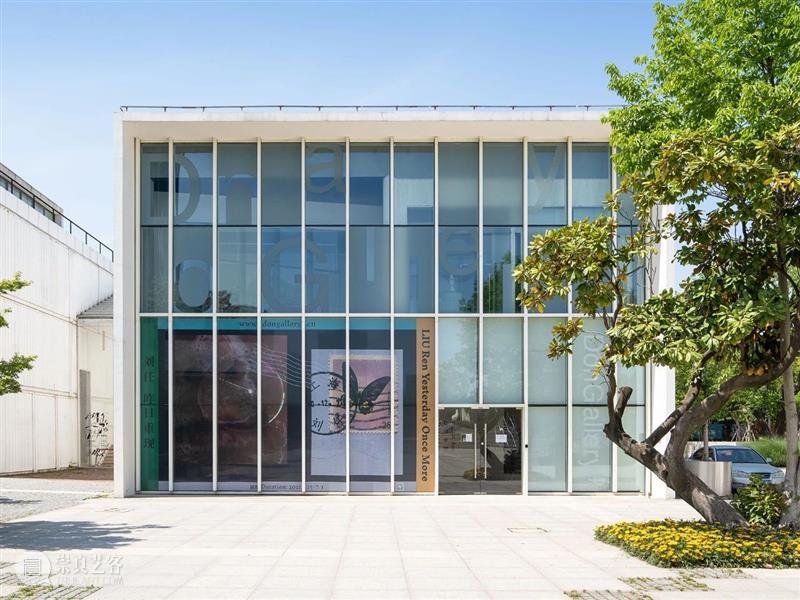
媒体联络 Media Contact
info@dongallery.com.cn
























 分享
分享